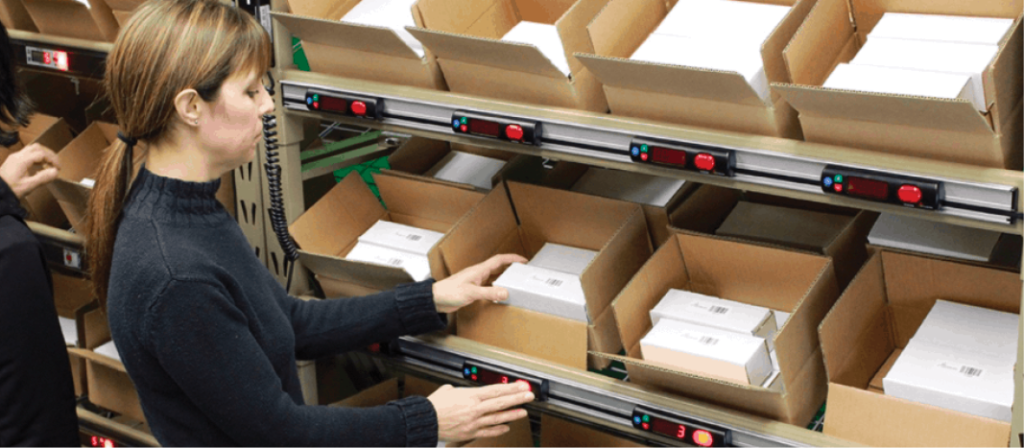This website uses cookies so that we can provide you with the best user experience possible. Cookie information is stored in your browser and performs functions such as recognizing you when you return to our website and helping our team to understand which sections of the website you find most interesting and useful using analytics.
Pick/Pack
Solutions
Overview
Pick-to-light systems are simple but robust systems designed to streamline your warehouse picking operations, thus increasing efficiency, productivity and picking accuracy, while simultaneously reducing costs.

How Does Pick to Light Work?
There are small variations in pick-to-light systems, but the basic workflow is as follows:
An operator scans a barcode that’s linked to an order and that’s attached to a temporary and reusable holding container (e.g. tote).
The system’s alphanumeric display (usually, LED lights) then lights up, indicating the product location(s) where the worker should proceed. The system indicates how many items should be picked at each location.
The operator picks the item(s), places them in the tote or container, and then presses a button to confirm the pick.
The system continues in this way, illuminating each location for picking until all items have been picked and placed in their respective tote or container.
Depending on the pick-to-light system, additional options may be available. Often, in addition to the LED display, pick to light also offers an acknowledgment button and a digital readout, to enable more detailed instructions and options. For example, your chosen system may allow employees to record basic data, such as variations in pick size; other systems could detail special instructions, order numbers, zone directions, or additional information.
What is a Put to Light System?
Put to light is essentially the inverse of a pick-to-light system: simply reverse the flow, and a put-to-light system will guide operators to organize incoming goods in a retail store, grouped as a customer order, or in any other organizational method.
How Does Put to Light Work?
Upon arrival at the put-to-light sorting area, each item is scanned. This triggers the light-directed modules to illuminate all locations representing a store or customer needing that item. Pickers distribute the items accordingly and extinguish the light once the task is complete. After an order is filled, the light-directed module can indicate that the order is complete and ready to ship.
What Are the Benefits?
As far as warehousing operations go, pick-to-light (or put-to-light systems) are excellent tools for increasing productivity and efficiency, as well as for reducing errors. But, of course, there’s more to it than that:
Ease of Use
Training operators in traditional picking can take hours – or more, depending on the size and complexity of your warehouse. With an efficient pick-to-light system, you can cut training down to 30-45 minutes.
System Integration
You can install a standalone pick-to-light system, of course, but depending on your warehousing needs, you can also integrate pick to light with an existing warehouse management system (WMS), enterprise resource planning (ERP), supply chain management, or other host systems, for better warehouse controls.
Furthermore, more advanced pick-to-light systems can produce pick-rate reports, analyze productivity and other metrics, and also allow for variance in the size of work zones, to account for labor-to-order volume needs.
Increased Efficiency
Pick-to-light systems are usually organized by your existing work zones, which helps minimize walking – and, therefore, boosts efficiency. Additionally, if an order is required to pass through multiple work zones, your pick-to-light system follows the order, helping reduce idle time.
You can even mount some pick-to-light systems onto mobile carts or conveyor systems, allowing a single operator to fulfill an entire order, through many zones of your warehouse.
It’s Paperless
Tied to the benefit of increased efficiency, it’s important to note the benefits of a paperless picking system. In short: Your operators save time when they eliminate the step of leafing through paper-based records.
Improved Accuracy
From a customer service standpoint, the greatest benefit to pick-to-light systems is fewer picking errors. Pick to light helps boost order fulfillment performance, which in turn nets happier end customers.
Lower Labor Costs
Traditional picking methods add up to one of the biggest expenses in warehouse operations. But, when you implement systems for less walking, shorter time to order fulfillment, greater order accuracy – all these factors lead to one major benefit to your warehouse: reduced labor costs.
This a natural result of greater productivity and efficiency, but it’s one very worth noting. Your pick-to-light system can easily pay for itself.
Now, you know: pick-to-light systems offer big advantages to warehouses, both big and small. Now, you tell us: Do you already use a pick-to-light system? If you don’t, why not?

